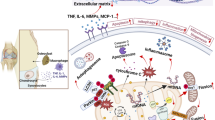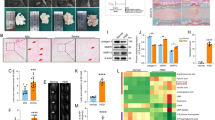Abstract
Paeonol, the main active component isolated from the root of Paeonia suffruticosa, has been reported to have anti-inflammatory properties. However, the effects of paeonol on osteoarthritis (OA) remain unclear. The aim of this study was to investigate the anti-inflammatory effects and mechanism of paeonol in IL-1β-induced human OA chondrocytes as well as mice OA models. Human OA chondrocytes were pretreated with different concentrations of paeonol 2 h prior to IL-1β (10 ng/mL) stimulation for 24 h. Nitric oxide (NO) production was determined by Griess method. The levels of prostaglandin E2 (PGE2), matrix metalloproteinase 1 (MMP-1), MMP-3, and MMP-13 were assessed by ELISA. Inducible nitric oxide synthase (INOS), COX-2, and PI3K/Akt/NF-κB-related signaling molecules production were measured by Western blot. In vivo, mice OA models were established by destabilization of the medial meniscus. One month after surgery, mice in paeonol-treated group were given intraperitoneal injection of paeonol in 30 mg/kg every day, while mice of vehicle-treated group were injected with DMSO under the same conditions. Hematoxylin and eosin as well as Safranin-O staining were applied to assess the severity of cartilage lesions. The results showed that pretreatment with paeonol could inhibit IL-1β-induced NO and PGE2 production. Meanwhile, the overproduction of INOS, COX-2, MMP-1, MMP-3, and MMP-13 were also reversed by paeonol. Moreover, paeonol was found to inhibit IL-1β-induced NF-κB activation, PI3K, and AKT phosphorylation. In vivo, treatment with paeonol exhibited less cartilage degradation and lower Osteoarthritis Research Society International scores in mice OA models. In conclusion, these results suggest that paeonol may be a potential therapeutic agent in the treatment of OA.







Similar content being viewed by others
References
Shen, J., and D. Chen. 2014. Recent progress in osteoarthritis research. Journal of the American Academy of Orthopaedic Surgeons 22 (7): 467–468.
Pelletier J P, Martelpelletier J, Ghandurmnaymneh L, et al. 1985. Role of synovial membrane inflammation in cartilage matrix breakdown in the Pond-Nuki dog model of osteoarthritis. [J]. 28(5):554–561.
Yang, C.C., C.Y. Lin, H.S. Wang, et al. 2013. Matrix metalloproteases and tissue inhibitors of metalloproteinases in medial plica and pannus-like tissue contribute to knee osteoarthritis progression. PloS One 8 (11): e79662.
Chen, B., M. Ning, and G. Yang. 2012. Effect of paeonol on antioxidant and immune regulatory activity in hepatocellular carcinoma rats. Molecules 17 (4): 4672–4683.
Dai M, Zhi X, Peng D, et al. 1999. [Inhibitory effect of paeonol on experimental atherosclerosis in quails] [J]. 24(8):488–90, 512.
Chae, Hee Sung, OkHwa Kang, Young Seob Lee, et al. 2012. Inhibition of LPS-induced iNOS, COX-2 and inflammatory mediator expression by paeonol through the MAPKs inactivation in RAW 264.7 cells. American Journal of Chinese Medicine 37 (1): 181–194.
Himaya, S.W., B. Ryu, Z.J. Qian, et al. 2012. Paeonol from Hippocampus kuda Bleeler suppressed the neuro-inflammatory responses in vitro via NF-κB and MAPK signaling pathways. Toxicology In Vitro 26 (6): 878–887.
Yuan, X., J. Chen, and M. Dai. 2016. Paeonol promotes microRNA-126 expression to inhibit monocyte adhesion to ox-LDL-injured vascular endothelial cells and block the activation of the PI3K/Akt/NF-κB pathway. International Journal of Molecular Medicine (6): 38.
Au, R.Y., T.K. Altalib, A.Y. Au, et al. 2007. Avocado soybean unsaponifiables (ASU) suppress TNF-alpha, IL-1beta, COX-2, iNOS gene expression, and prostaglandin E2 and nitric oxide production in articular chondrocytes and monocyte/macrophages. Osteoarthritis & Cartilage 15 (11): 1249–1255.
Vasheghani, F., Y. Zhang, Y.H. Li, et al. 2014. PPARγ deficiency results in severe, accelerated osteoarthritis associated with aberrant mTOR signalling in the articular cartilage. Annals of the Rheumatic Diseases 74 (3): 569.
Pritzker, K.P., S. Gay, S.A. Jimenez, et al. 2006. Osteoarthritis cartilage histopathology: grading and staging. Osteoarthritis & Cartilage 14 (1): 13–29.
Chen, W.P., J.L. Tang, J.P. Bao, et al. 2011. Anti-arthritic effects of chlorogenic acid in interleukin-1β-induced rabbit chondrocytes and a rabbit osteoarthritis model. International Immunopharmacology 11 (1): 23–28.
Li, X.H., X. Tong, Z. Jing, et al. 2016. Paeonol suppresses neuroinflammatory responses in LPS-activated microglia cells. Inflammation 39 (6): 1–14.
Liu, M.H., A.H. Lin, H.F. Lee, et al. 2014. Paeonol attenuates cigarette smoke-induced lung inflammation by inhibiting ROS-sensitive inflammatory signaling. Mediators of Inflammation 69 (2014): 208–218.
Kobayashi, M., G.R. Squires, A. Mousa, et al. 2005. Role of interleukin-1 and tumor necrosis factor α in matrix degradation of human osteoarthritic cartilage. Arthritis and Rheumatism 52 (1): 128–135.
Goldring, M.B., J. Birkhead, L.J. Sandell, et al. 1988. Interleukin 1 suppresses expression of cartilage-specific types II and IX collagens and increases types I and III collagens in human chondrocytes. Journal of Clinical Investigation 82 (6): 2026–2037.
Goldring, S.R., and M.B. Goldring. 2004. The role of cytokines in cartilage matrix degeneration in osteoarthritis. Clinical Orthopaedics & Related Research 427 (427 Suppl): S27.
Ma, Z., Y. Wang, T. Piao, et al. 2016. Echinocystic acid inhibits IL-1β-induced COX-2 and iNOS expression in human osteoarthritis chondrocytes. Inflammation 39 (2): 543–549.
Vincenti, M.P., and C.E. Brinckerhoff. 2002. Transcriptional regulation of collagenase (MMP-1, MMP-13) genes in arthritis: integration of complex signaling pathways for the recruitment of gene-specific transcription factors. Arthritis Research & Therapy 4 (3): 157–164.
Jin, X., J. Wang, Z.M. Xia, et al. 2016. Anti-inflammatory and anti-oxidative activities of paeonol and its metabolites through blocking MAPK/ERK/p38 signaling pathway. Inflammation 1: 1–13.
Largo, R., M.A. Alvarez-Soria, I. Díez-Ortego, et al. 2003. Glucosamine inhibits IL-1beta-induced NFkappaB activation in human osteoarthritic chondrocytes. Osteoarthritis & Cartilage 11 (4): 290.
Zhang, H., J. Yan, Y. Zhuang, et al. 2015. Anti-inflammatory effects of farrerol on IL-1β-stimulated human osteoarthritis chondrocytes. European Journal of Pharmacology 764: 443.
Wang, L., Y. Xu, Q. Yu, et al. 2014. H-RN, a novel antiangiogenic peptide derived from hepatocyte growth factor inhibits inflammation in vitro and in vivo through PI3K/AKT/IKK/NF-κB signal pathway. Biochemical Pharmacology 89 (2): 255–265.
Acknowledgments
This work is supported by grants from the National Nature Foundation of China (no. 81472146) and Wenzhou Science and Technology Bureau Foundation (no. Y20160135).
Author information
Authors and Affiliations
Corresponding authors
Ethics declarations
The study was in accordance with the Declaration of Helsinki and Tokyo.
Conflict of Interest
The authors declare that they have no conflict of interest.
Rights and permissions
About this article
Cite this article
Lou, Y., Wang, C., Tang, Q. et al. Paeonol Inhibits IL-1β-Induced Inflammation via PI3K/Akt/NF-κB Pathways: In Vivo and Vitro Studies. Inflammation 40, 1698–1706 (2017). https://doi.org/10.1007/s10753-017-0611-8
Published:
Issue Date:
DOI: https://doi.org/10.1007/s10753-017-0611-8




